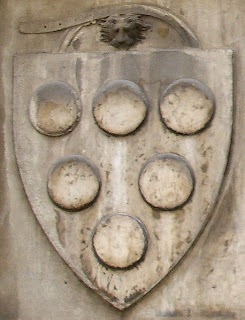Quick - who's the first Medici who pops into your mind?
We'll just ignore anybody who said "What's a Medici?" Here are a few random possibilities, depending on what period(s) of history you're interested in:
- Catherine de' Medici, 1519-1589. Known for Huguenots, forks, astrology, and for being Queen of France.
- Cosimo I, 1519-1574. Grand Duke of Florence from 1537-1569; Grand Duke of Tuscany 1569-1574. Known for power, ruthlessness, extravagant public spectacles and building projects, and having rather a lot of money.
- Pope Leo X (born Giovanni de' Medici), 1475-1521. Known for becoming a cardinal at the tender age of 16, for being nearsighted, for his girth, and for saying, "God has give us the papacy - now let us enjoy it!"
His mother was the redoubtable Caterina Sforza, whose maternal attitude may be summed up in this anecdote:
The year is 1488. Caterina's first husband has just been assassinated, and her enemies are holding her six children hostage and threatening to kill them if she won't surrender her fortress. Does Caterina give in gracefully? Heck, no. She stands atop the ramparts, lifts her skirts, and yells, "Fools! Can you not see that I can make more?" (Probably apocryphal, but still.) With a mom like that, no wonder Giovanni was a bit scrappy. He was the son of her third husband, Giovanni de' Medici.
Or perhaps your interests run a bit earlier, and the Medici that comes to mind is Lorenzo, called "The Magnificent" (1449-1492).
Lorenzo was my own entry-level Medici. Known for his poetry, his patronage of artists, his political skill and courage, his total lack of a sense of smell, and his problems with the religious reformer Fra Girolamo Savonarola (sometimes called the Mad Monk of Florence).
There are the Medici who survived assassination attempts (Lorenzo), and those who didn't (Alessandro). There are the Medici who led revolts (Salvestro), and those who were revolted against (Piero di Lorenzo). There are the Medici who survived the plague and wrote about it (Filigno), and those who didn't (Bicci).
In short, we have Medici up the wazoo.
Um - let me reword that, more in keeping with the serious intent and overall gravitas of this blog: We can find records of many, many notable members of the Medici family, going back a long way.
We can, with reasonably good documentation, take this family back to a birth around the year 1046. To a time before the family had adopted their surname, let alone their famous coat of arms. To a time before they settled in Florence.
We can go back all the way to Catherine de' Medici's 16X-great-grandfather.
Of course, historians seem to believe the Medici accomplished most of this without women, via some sort of weird parthenogenesis. The only times women get listed in these charts and family trees seems to be when they come from prestigious families and they marry into the Medici (who were not of the nobility). Thus, we find Contessina ADIMARI, Jacopa SPINI, Gemma de' BARDI, and Lisa DONATI, all of whom lent their families' status and political clout to the up-and-coming Medici. Medici daughters do get mentioned occasionally, but usually it's when they marry notably well.
What I propose to do in my next few blog posts is to go back in time. Next time, I want to take a look at Giovanni di Bicci de' Medici (1360-1428), who started the Medici bank (and fortune).
Then I want to look at Salvestro's role in the Ciompi revolt (1378) and see what we can learn from reading Foligno's family ricordanza (begun in 1373).
I'll want to see what the Medici were up to in the time periods covered by my published novel (1216), my work in progress (mid-1200s), and my next project (late 1200s-early 1300s). I'll take a look at the Medici's allegiance to the Black Guelf faction under the leadership of Corso Donati, and we'll look at Neri Strinati's indignant claim that a "gang" of Medici invaded his house and stole everything, including the clothing of the infants in their cribs (1301).
And then we'll take a look at some really early stuff. Maybe we'll even peek into the mists of Medici legend - and I can assure you they're pretty misty, especially the part about slaying giants for Charlemagne.
So, as my friends in the Society for Creative Anachronism would say, "Forward into the past!"
Images in this post are in the public domain.
.jpg)







3 comments:
Wonderful, Tinney. I'm in the middle of a Medici blog series myself, I started back in May. They are truly an enigmatic and magnetic family.
Donna, I'm glad you posted. This gives me a chance to say that any readers who want to read a more thorough, detailed, and serious blog series about the Medici should go to your blog http://donnarussomorin.blogspot.com/2013/05/the-medici-true-dynasty-very-beginnings.html (not sure how to turn this into a link, but this is the first of Donna's Medici posts, and it and those that follow are well worth reading). As usual, I'm doing a rather light once-over, concentrating on only a few family members, but if readers want more, they should definitely go to Donna's blog. I've certainly learned some things there!
This is truly very nice post,I just read through the entire article and I much enjoyed reading your article it is really very informative. and I would like to tell you that you have more people like me who really appreciate your work.Its definitely a great post.Thanks for sharing this informative information.
house of medici
Post a Comment